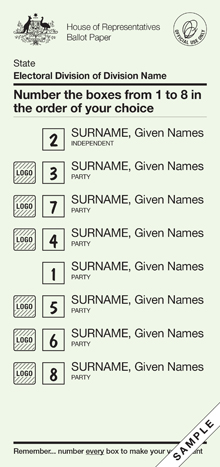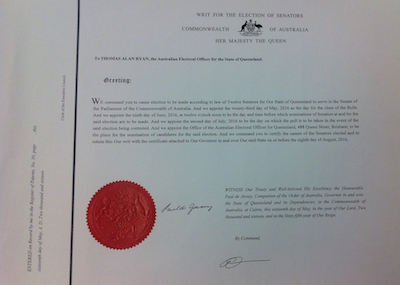Election 2016
24 May, 2016
Musings on the forthcoming double-dissolution election.
First, and most importantly
You can’t “waste your vote”

Sample House of Representatives ballot
We use Full Preferential Voting (known to other countries as Alternative Vote, or Instant-Runoff Voting) in all Commonwealth and State/Territory elections. This means that if no one gets over 50% of the vote then the candidate with the least votes is removed from the count and the second preference of everyone who voted for that candidate is counted again.
If still no candidate has 50% of the vote, the candidate who got the least amount of votes in the second-round count (including second preference votes from the first candidate to be removed) is also removed from the count and their voter’s second preference (or third preference, for those whose 1st preference was the first candidate to be eliminated) votes are distributed and the cycle continues until one candidate has over 50% of the vote.
In effect, this simulates running multiple elections and ensures that no one has to deal with the ridiculous “tactical voting” scenarios in other countries where voters often feel that they are forced to vote for the “lesser of two evils” rather than the candidate they actually like.
See the most excellent comic by Patrick Alexander for a more entertaining explanation, or watch CGP Gray explain in the video below.
How an election happens
At Yarralumla
We live in a Westminster-style democracy.
The Parliament on Capital Hill, the High Court on the shores of Lake Burley Griffin and the Governor-General at the old station homestead[1] of Yarralumla all represent different parts of “the government”, and have different parts to play in an election.
Under normal circumstances, the Prime Minister decides to throw an election and then advises the Governor-General of the date that they have chosen. Since we live in a constitutional monarchy, convention dictates that the Crown, or in most cases, viceroy, does what they are told almost all of the time.
Of course, there was also that one time when things happened differently, and the Governor-General made an election happen because Parliament wasn’t playing nicely together. So he sent them all home.
Either way, once the decision is made to have an election, the existing Parliament is dissolved by proclamation of the Governor-General.
Dropping the Writs
The document that formally sets the date for the election and all the other necessary administrivia is called a Writ. In earlier times there was a writ for each seat, which was signed by the electorate’s Returning Officer and taken back to the Parliament (or “returned” if you will) by the winning candidate. This was effectively the new parliamentarian’s ticket into the House, but these days things are a bit simpler. The Governor-General issues three writs: for the election of all the members of the House of Representatives, for the election of the Senators from the Northern Territory, and for the election of the Senators from the ACT.
But thanks to Section 12 of the Constitution, the State Governors are the ones to issue writs for the election of the senators from their state — on the instruction of their Premier. State Parliaments are also responsible for filing casual Senate vacancies, although since the unpleasantness, they now rubber-stamp the choice of the political party the Senator was a member of when elected.
Writ for the election of Queensland's 12 Senators
WRIT FOR THE ELECTION OF SENATORS
COMMONWEALTH OF AUSTRALIA
HER MAJESTY THE QUEENTo THOMAS ALAN RYAN, the Australian Electoral Officer for the State of Queensland.
Greeting:
We command you to cause election to be made according to law for Twelve Senators for Our State of Queensland to serve in the Senate of the Parliament of the Commonwealth of Australia. And we appoint the twenty-third day of May, 2016 for the close of the Rolls. And we appoint the ninth day of June, 2016 at twelve o'clock to be the day and time before which nominations of Senators at and for the said election are to be made. And we appoint the second day of July, 2016 to be the day on which the poll is to be taken in the event of the said election being contested. And we appoint the Office of the Australian Electoral Officer for Queensland, 488 Queen Street, Brisbane, to be the place for the nomination of candidates for the said election. And we command you to certify the names of the Senators elected and to return this Our writ with the certificate attached to Our Governor in and over Our said State on or before the eighth day of August, 2016.
WITNESS Our Trusty and Well-beloved His Excellency the Honourable Paul de Jersey, Companion of the Order of Australia, Governor in and over the State of Queensland and its Dependencies, in the Commonwealth of Australia, at Cairns, this sixteenth day of May, in the year of Our Lord, Two thousand and sixteen, and in the Sixty-fifth year of Our Reign.
The instructions in the writ are more or less the same for each State, being proscribed by the Commonwealth Electoral Act 1918, and by various state laws with names like the Senate Elections Act — which just so happen to be effectively identical.[2]
Elections: Double-Dissolution and Half-Senate
150 MPs are elected from single-member constituencies across the country for three year terms. All MPs, and the Senators from the Territories, are elected each time the House of Representatives is dissolved — something the constitution requires is done at least every three years, however the exact timing of elections for the House of Reps is decided by the Prime Minister, and they can choose to call an election earlier if it suits their political interests.
There are currently 76 Senators,[3] twelve from each state; plus two each from the Northern Territory and the ACT (they represent the external territories as well.) State Senators are elected to six year terms, with half of the Senators facing re-election every three years and new Senators taking their seats on July 1st. Half-Senate Elections must be held within 12 months of when the new Senators will take their seats, and so one of the things that the Prime Minister usually considers when deciding the timing of elections for the House of Representatives. The last time that a Half-Senate Election was not held simultaneously with the House elections was in 1970.
We took the half-senate election thing from the US, but double-dissolution elections are a wholly-Australian innovation. Unlike the Canadian Senate or the House of Lords, there is no way to appoint new members to the Australian Senate, so a different way to resolve deadlocks between the two Houses of Parliament was required.
If the Senate rejects a bill, then after three months rejects it again, then the Prime Minister can request a double-dissolution election to clear the deadlock. If the Senate still won’t pass the bill, the Governor-General can then call a joint sitting of Parliament. With the members of both Houses sitting together as a combined body to consider the bills, and the size of the House doubling the size of the Senate, the newly-returned Government’s majority is generally considered enough to guarantee the passage of the controversial bills.
So far as I am aware, Australia is the only country in the world that does double-dissolution elections or has provision for both houses of parliament to sit together to resolve disputes, so that’s pretty cool.
Notes
[1] Yes, the Governor-General's house used to be a sheep station. This is Australia. Of course it used to be a sheep station.</p>
[2] There is not a lot that the States are as keen on as asserting their independence from the Commonwealth.</p>
[3] No, it is not a coincidence that the House has twice as many members as the Senate.</p> </div>
